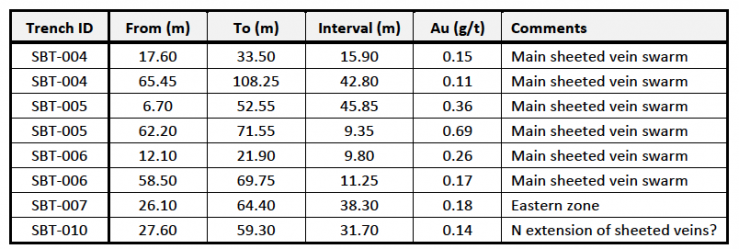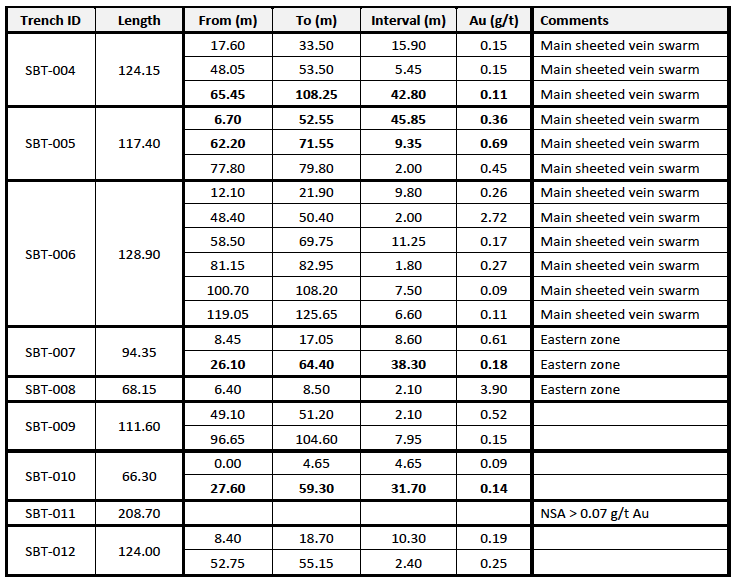Aton Announces The Final Results Of Surface Trenching At The Sir Bakis Prospect, And Confirms The Presence Of A Broad Zone Of Anomalous Surface Gold Mineralization
Vancouver, March 19, 2018: Aton Resources Inc. (AAN: TSX-V) (“Aton” or the “Company”) is pleased to provide investors with an update on exploration activities at the Company’s 100% owned Abu Marawat Concession (“Abu Marawat” or the “Concession”), and to announce final gold assay results from the surface trenching programme at the Sir Bakis prospect, and initial grab sampling assay results from Sidi Samarin.
Highlights:
- A total of 12 machine excavated trenches have been completed at the Sir Bakis prospect (SBT-001 to SBT-012);
- Trenching has confirmed the presence of a broad zone of anomalous gold mineralization at surface, associated with a sheeted vein swarm, returning intersections including 45.85m @ 0.36 g/t Au (trench SBT-005), and suggestive of RIRG style mineralization;
- A short programme of selective grab sampling from the Sidi Samarin area, approximately 2.5km north-west of Sir Bakis, has returned gold assay values including 9.78 g/t Au and 4.86 g/t Au.
“These results from one of the historic mining areas within our license show real promise. The British last mined at Sir Bakis early in the last century, but there has been mining activity there since Pharaonic times.” said Mark Campbell, President and CEO. ”The results also help us confirm our understanding of the geology in this part of the Concession, as we have various styles of mineralization throughout our license.”
Sir Bakis Prospect
The Sir Bakis prospect is located approximately 12km NE of the Company’s Hamama West mineral deposit, and approximately 10km NW of the new Rodruin discovery (see Figure 1), and has been extensively worked in both ancient and modern times. There are significant ancient mine workings and the remains of ancient settlements spread over a wide area at Sir Bakis, and archaeological evidence suggests that mining dates back to the New Kingdom period, over 3,000 years ago.
The Main Vein at Sir Bakis, which was the focus of the modern underground mining between 1904 and 1906 by a British company, Eridia (Egypt) Exploration Company, can be traced at surface for a distance of some 1.6km in a N-S strike direction. The Main Vein is a high grade sheared quartz vein and was mined at widths of up to 1.5m underground. Approximately 600m NW of the British adits there is a zone of very narrow sheeted quartz veins which have been worked extensively at surface to shallow depths in ancient times. The sheeted vein swarm is approximately 400m along its N-S strike length at surface, and in excess of 100m in width. Results from the initial phase of trenching over the sheeted vein swarm included an intersection of 109.1m @ 0.21 g/t Au (trench SBT-001, see news release dated September 13, 2017).
There are also a number of other major veins in the area, to the NW of the modern mine workings, and numerous smaller veins and shears through the area which have been worked by the ancients. Previous channel sampling at Sir Bakis by the Company has returned assays of up to 29.5 g/t Au from the Main Vein, and 7.94 g/t Au from the westernmost vein. A selective grab sample of vein quartz from the northern extension of the Main Vein workings returned an assay of 32.9 g/t Au (see news release dated September 13, 2017).

Figure 1: Abu Marawat regional geology, showing the location of the Sir Bakis prospect Surface trench sampling

Figure 2: Location of the Sidi Samarin and Sir Bakis prospects

Figure 3: Sir Bakis trench and sample locations, showing gold assay results
The surface trenching programme was completed during 2017 at Sir Bakis for a total of 12 trenches (SBT-001 to SBT-012 inclusive) with a total excavated length of 1,762.5m. Assay results from the first 3 trenches, SBT-001 to SBT-003 have previously been reported (see news release dated September 13, 2017). The locations of the trenches are shown in Figure 3 above. The trenches were manually channel sampled, over nominal 2m intervals, with a total of 918 samples being collected over the entire programme. All samples were crushed to -4mm at the Company’s onsite sample preparation facility at Hamama, with c. 500g splits shipped to ALS Minerals at Rosia Montana, Romania for analysis. All samples were analyzed for gold by fire assay using analytical code AA-Au23.
Trenches SBT-001 to SBT-002, SBT-004 to SBT-006, and SBT-009 targeted the sheeted vein swarm, with the remainder targeting various other veins and structures. Results from the trenches continue to be very encouraging with strongly anomalous results being returned from all trenches, except trench SBT-011. Mineralized intersections from all trenches SBT-004 to SBT-012 are provided in Appendix A, and selected intervals are presented below in Table 1.
Trenches SBT-004, SBT-005, and SBT-006 all intersected broad zones of anomalous surface mineralization over the main sheeted vein swarm, confirming the highly anomalous interval of 109.1m @ 0.21 g/t Au previously reported from trench SBT-001, with intersections including 45.85m @ 0.36 g/t Au and 9.35 @ 0.69 g/t Au (trench SBT-005). There are many shallow, narrow ancient workings over the sheeted vein swarm (see Figure 3), typically less than a meter in width to a maximum of 3-4m depth, with the highest grade quartz veins having been removed by the ancient miners. It is therefore considered highly probable that the trench assays have underestimated the true grade of the mineralized interval at surface, prior to the ancient shallow mining activity, due to the selective removal of high grade quartz veins.

Table 1: Selected mineralized intersections from Sir Bakis trenches SBT-004 to SBT-012
The main sheeted vein swarm appears to be offset by a fault which is approximately parallel to trench SBT-002, and the anomalous mineralization intersected in trenches SBT-007 and SBT-008 suggests the possibility of a separate eastern vein swarm zone possibly extending to the south under wadi sediments.
The Company continues to be very encouraged by the trench results and believes that the sheeted vein style mineralization identified at Sir Bakis displays strong affinities with reduced intrusion related gold (RIRG) systems, possibly associated with blind stocks or apophyses of granite associated with the late Ria al Jarrah granite (see Figure 2). Small, irregular outcrops of distinctive pink granite stocks have been mapped at Sir Bakis area in the immediate area of the identified mineralization.
Sidi Samarin Prospect
A short first-pass programme of selective grab sampling has been completed at the Sidi Samarin prospect, located approximately 2.5km NW of the Sir Bakis prospect (See Figure 4). The Sidi Samarin area is located within a wedge of predominantly orogenic ‘grey granites’, with minor metavolcanics located between the late Ria al Jarrah and Garida granite plutons (see Figures 1 and 2). Mineralization in the area is primarily associated with narrow, sheared and iron-stained quartz veins, hosted mainly in granodiorites, and appears to be similar to that at the Massaghat prospect (see Figure 2), which has returned gold assay values of up to 470 g/t Au (see news releases dated August 15, 2012 and 4 December, 2017). There are a number of small, isolated ancient workings in the Sidi Samarin area, exploiting such quartz veins.

Table 2: Details of Sidi Samarin grab samples
A short programme of selective grab sampling has been completed at Sidi Samarin, with encouraging results. All samples were crushed to -4mm at the Company’s onsite sample preparation facility at Hamama, with c. 500g splits shipped to ALS Minerals at Rosia Montana, Romania for analysis. All samples were analyzed for gold by fire assay using analytical code AA-Au23. Details of the samples are provided above in Table 2, and sample locations are shown in Figure 4. Of the 13 samples, 5 returned assays greater than 1 g/t Au, and results included assays of up to 9.78 g/t and 4.86 g/t Au.

Figure 4: Sidi Samarin sample locations, showing gold assay results
Activity update:
The Company remains on course to submit its financial and technical study on the Hamama West deposit to the Egyptian Mineral Resources Authority by May 2018, in support of its intention to declare a commercial discovery at Hamama (see news release, dated November 20, 2017);
Geotechnical trial pitting at 2 potential locations for the Hamama West heap leach facility has been completed, and it is anticipated that samples will be submitted to an ISO certified laboratory in Cairo within the next week for geotechnical testwork;
The final report on the deep ground penetrating radar geophysical survey has now been completed by Terravision Exploration, with the survey having identified a number of promising new targets. Further details of the GPR survey will be released soon;
Additional surface sampling has been completed at the Rodruin prospect to follow up on the highly promising initial surface sampling results (see news releases dated February 6, 2018 and March 5, 2018). Samples have been dispatched to ALS Romania for analysis, and further updates will be provided shortly;
Construction of the Rodruin access road has commenced, and the road is progressing well. Drilling is planned to start at Rodruin, as soon as the access road has been completed and drill pads have been constructed.
About Aton Resources Inc.
Aton Resources Inc. (AAN: TSX-V) is focused on its 100% owned Abu Marawat Concession (“Abu Marawat”), located in Egypt’s Arabian-Nubian Shield, approximately 200 km north of Centamin’s Sukari gold mine. Aton has identified a 40 km long gold mineralized trend at Abu Marawat, anchored by the Hamama deposit in the west and the Abu Marawat deposit in the east, containing numerous gold exploration targets, including three historic British mines. Aton has identified several distinct geological trends within Abu Marawat, which display potential for the development of RIRG and orogenic gold mineralization, VMS precious and base metal mineralization, and epithermal-IOCG precious and base metal mineralization. Abu Marawat is over 738km2 in size and is located in an area of excellent infrastructure; a four-lane highway, a 220kV power line, and a water pipeline are in close proximity.
Qualified Person
The technical information contained in this News Release was prepared by Roderick Cavaney BSc, MSc (hons), MSc (Mining & Exploration Geology), FAusIMM, GSA, SME, Vice President, Exploration, of Aton Resources Inc. Mr. Cavaney is a qualified person (QP) under National Instrument 43-101 Standards of Disclosure for Mineral Projects.
For further information regarding Aton Resources Inc., please visit us at www.atonresources.com or contact:
Mark Campbell
President and Chief Executive Officer
Tel: +202-27356548
Email: mcampbell@atonresources.com
Note Regarding Forward-Looking Statements
Some of the statements contained in this release are forward-looking statements. Since forward-looking statements address future events and conditions; by their very nature they involve inherent risks and uncertainties. Actual results in each case could differ materially from those currently anticipated in such statements. Neither TSX Venture Exchange nor its Regulation Services Provider (as that term is defined in policies of the TSX Venture Exchange) accepts responsibility for the adequacy or accuracy of this release.
Appendix A – Sir Bakis trench intersection results

